Understanding Large-Scale Mortuary Storage Solutions
A 100 Body Mortuary Cooler is a specialized walk-in refrigeration unit designed to preserve and store up to 100 deceased individuals in a temperature-controlled environment. For funeral directors, medical examiners, and disaster response teams needing substantial capacity, here's what you need to know:
| Feature | Specifications for 100 Body Mortuary Cooler |
|---|---|
| Typical Dimensions | 20'×30'×8' (varies by configuration) |
| Temperature Range | 36°F-39°F (2°C-4°C) |
| Power Requirements | 220/230V AC, often 3-phase |
| Construction | 4" insulated panels, stainless steel interior |
| Standard Features | Digital temperature control, alarm systems, LED lighting |
| Common Applications | Hospitals, disaster response, municipal morgues |
Large-capacity mortuary coolers have become increasingly essential for facilities that need to manage substantial caseloads or prepare for emergency situations. Unlike standard 2-12 body units commonly found in funeral homes, 100-body systems use modular walk-in designs with specialized rack systems to maximize space efficiency while maintaining proper temperature control.
These high-capacity units represent a significant investment but provide crucial infrastructure for hospitals, medical examiner offices, and municipalities that must handle mass casualty events or seasonal surges. Modern 100-body systems incorporate energy-efficient technologies, redundant cooling systems, and advanced monitoring to ensure reliable performance.
I'm Mortuary Cooler, a national-level mortuary cooler supplier with extensive experience designing and installing 100 Body Mortuary Cooler systems throughout the United States. My work with large-scale refrigeration projects has helped numerous institutions develop efficient and reliable solutions for their most demanding preservation needs.
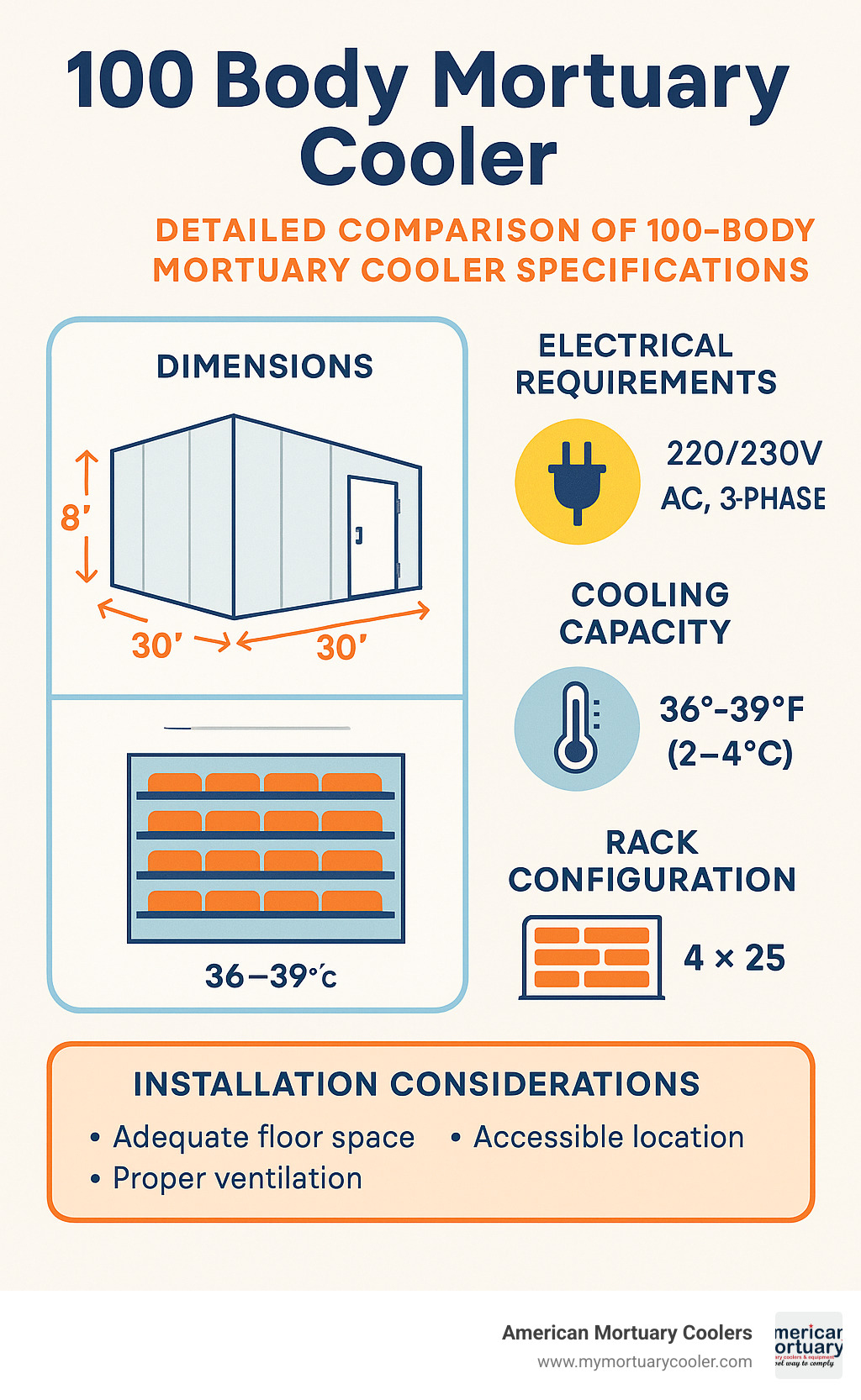
100 Body Mortuary Cooler glossary:
- Walk-In Mortuary Cooler Sizes
- large walk in cooler
- funeral home refrigeration units
Search Intent & What You'll Learn
In this comprehensive guide, we'll explore everything you need to know about high-capacity mortuary refrigeration systems. Whether you're researching options for a hospital expansion, municipal morgue upgrade, or disaster response planning, you'll find:
- A detailed product roundup of the top 100 Body Mortuary Cooler and 500-body cooler solutions
- Key specifications and design considerations for large-capacity systems
- Installation requirements and operational best practices
- A buyer's checklist to ensure you select the right solution for your facility
Let's explore large-scale mortuary refrigeration and help you find the perfect cooling solution for your unique needs.
Why Large-Capacity Body Storage Matters
When the COVID-19 pandemic swept across the world, it revealed a stark reality many facilities weren't prepared for – the critical need for adequate mortuary capacity. I've spoken with countless funeral directors who shared heartbreaking stories of dignity compromised when their small coolers couldn't handle the sudden surge.
"During peak pandemic periods, our 12-body cooler was completely inadequate," Dr. Maria Sanchez, Medical Examiner for a large metropolitan county, told me recently. "Having a 100 Body Mortuary Cooler would have made an enormous difference in our ability to maintain dignity and proper care standards."
The pandemic taught us a lesson we can't afford to forget. Proper planning for deceased care isn't morbid – it's necessary and compassionate.
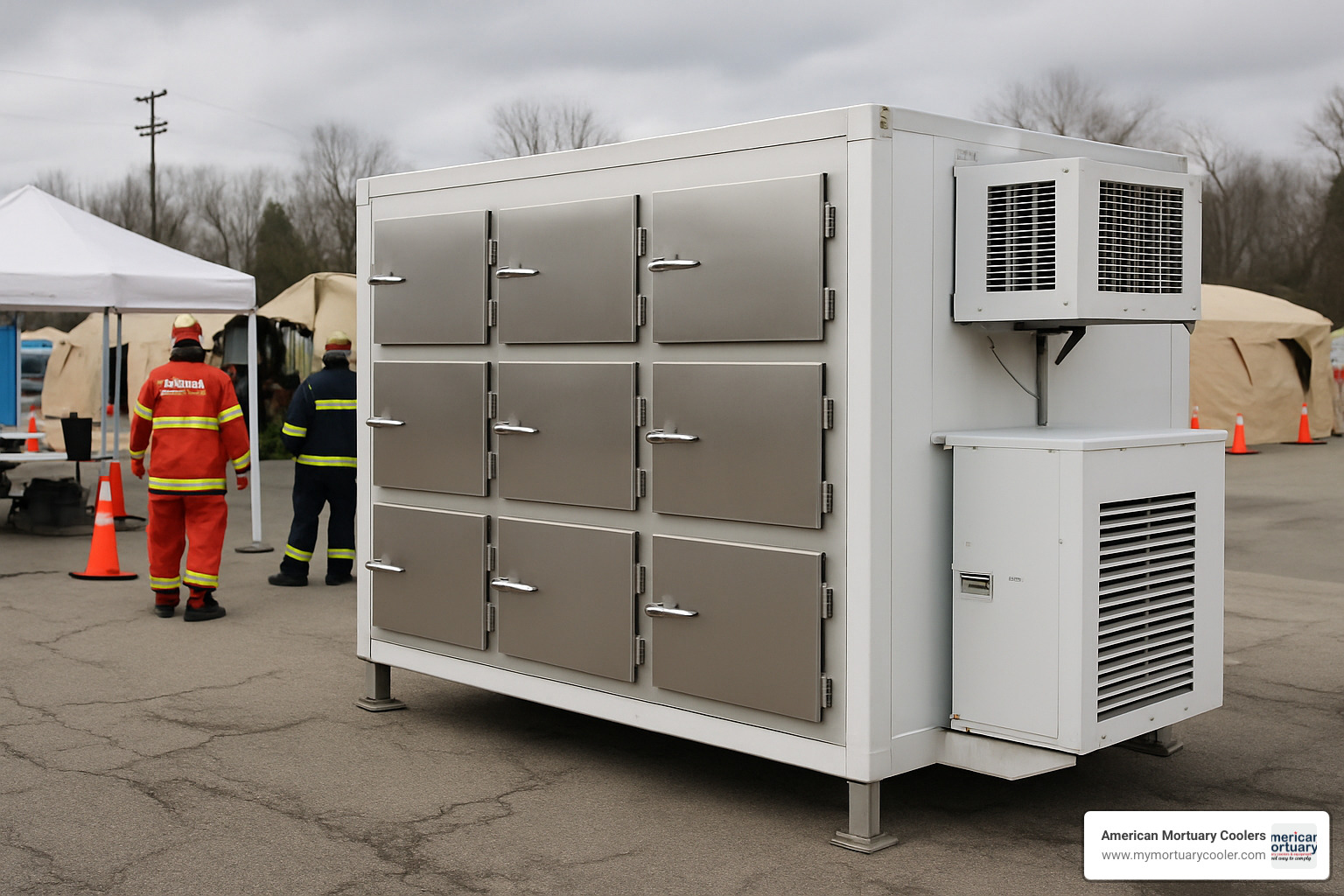
Large-capacity cooling systems have become essential for multiple types of facilities. Hospital morgues often face overflow challenges, especially in teaching hospitals where cases may remain longer for educational purposes. Municipal emergency management agencies must prepare for natural disasters where traditional systems might be overwhelmed. Medical examiner offices require substantial space for cases awaiting investigation, particularly in populous counties. And military units and FEMA deploy large refrigeration systems during humanitarian crises to ensure proper care of the deceased.
I recently visited a funeral home in Southern California that had upgraded to a larger capacity system. The director proudly shared: "With the 8'x12' CoolBot system, I've become the largest refrigeration facility for human remains in Southern California." This wasn't just about capacity – it represented their commitment to serving their community with dignity, even during difficult times.
The shift toward larger systems makes practical sense too. Rather than scrambling for temporary solutions during emergencies (like the refrigerated trucks we saw during COVID peaks), facilities are recognizing the operational efficiencies of having proper capacity already in place. It's not just about emergency preparedness – it's about providing consistently dignified care.
For many facilities, a 100 Body Mortuary Cooler represents peace of mind. It ensures they'll never have to compromise on the respectful treatment of the deceased, even during the most challenging circumstances.
Want to learn more about optimizing your morgue storage? Check out our detailed guide on maximizing morgue storage for effective operations for additional insights.
100 Body Mortuary Cooler: Core Specifications & Design
When you're looking at a 100 Body Mortuary Cooler, you're stepping into serious refrigeration territory. These aren't your standard funeral home units – they're robust systems built specifically for facilities that need substantial capacity with rock-solid reliability.
Let me walk you through what makes these systems special. A typical 100 Body Mortuary Cooler occupies between 600-900 square feet, depending on how you arrange the racks inside. The walls consist of 4-inch high-density insulated panels with no wood core – an important detail that dramatically improves energy efficiency and longevity.
The insulation itself deserves attention too. Most quality units use either polyurethane (PU) or polyisocyanurate (PIR) foam with impressive R-values exceeding 25. This keeps the cold air in and the warm air out, reducing energy costs significantly over time.
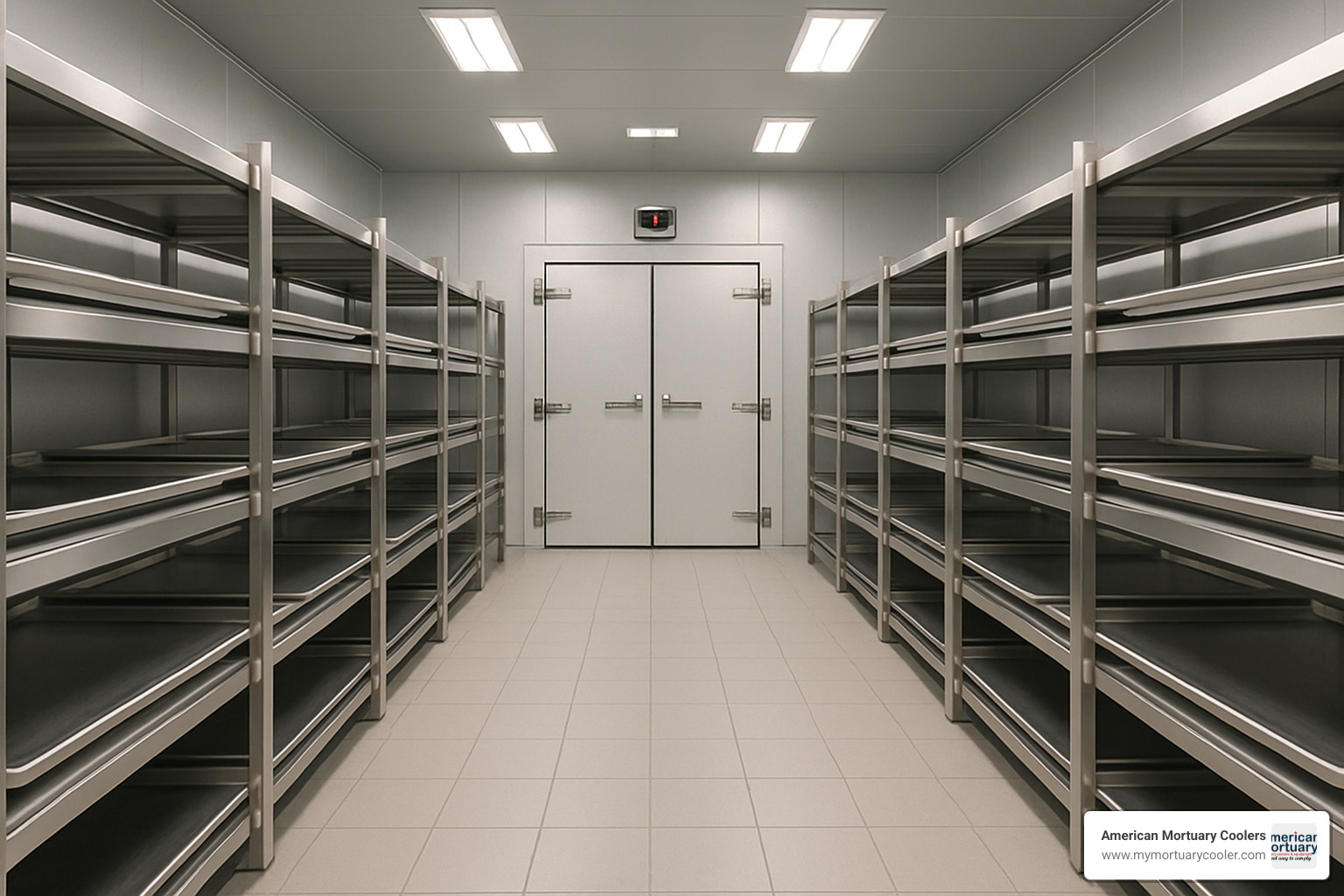
Inside, you'll find stainless steel interiors (typically grade 304) that stand up to rigorous cleaning protocols while maintaining their integrity year after year. The doors are something special too – vapor-tight, self-closing units with magnetic gaskets and chrome-plated hardware that create a perfect seal every time.
The cooling system itself is typically a commercial-grade split system with remote condensers, controlled by digital controllers that monitor multiple probe locations throughout the space. This ensures consistent temperatures with no warm spots – critical for proper preservation.
All modern 100 Body Mortuary Cooler systems must comply with the Federal Energy Independence & Security Act (EISA) of 2007, Title III, section 312. It's not just red tape – these standards ensure your system operates efficiently for years to come. Additionally, quality panels should be UL-NSF approved and meet ASTM E84 requirements for smoke and flame spread.
Here's how these systems compare to their larger cousins:
| Feature | 100-Body Cooler | 500-Body Cooler |
|---|---|---|
| Typical Footprint | 600-900 sq ft | 2,500-3,500 sq ft |
| Rack Configuration | 3-tier standard | 3-5 tier high-density |
| Power Requirements | 220V, 50-60A | 3-phase, 100-200A |
| Refrigeration System | Split system, 5-8 ton | Multiple zones, 20-30 ton |
| Installation Timeline | 1-2 weeks | 3-4 weeks |
| Approximate Cost | $85,000-$150,000 | $300,000-$500,000 |
100 Body Mortuary Cooler Applications
The versatility of these systems makes them ideal for several specialized applications. During disaster response scenarios, a 100 Body Mortuary Cooler provides crucial capacity for managing mass-casualty events. FEMA and state emergency management teams often maintain access to these systems for just such situations.
Teaching hospitals with anatomical donation programs find these units indispensable. As one Chicago facility administrator told me, "Our 100-body walk-in cooler maintains the perfect temperature range of 37-38°F consistently, which is essential for our anatomical donation program."
Medical examiner offices and forensic labs particularly benefit from the expanded capacity, which allows proper organization of cases requiring extended investigation periods. The extra space means cases can be properly arranged rather than stacked or crowded.
Standard Dimensions & Configurations
While every facility has unique needs, certain standards have emerged in the industry. Most 100 Body Mortuary Cooler systems use 30-inch wide trays – wide enough for most decedents while maximizing storage density.
The rack systems typically feature 3 tiers, though 4-tier arrangements are possible with sufficient ceiling height. When it comes to loading orientation, you have options. Side-loading racks allow bodies to slide in from the side, requiring wider aisles but making loading easier. End-loading racks maximize space efficiency but require more careful maneuvering during loading and unloading.
One of the most appealing aspects of these systems is their modular construction. As a facility manager in Texas explained to me, "We started with a 50-body capacity and expanded to 100 bodies by adding additional panels and racks without disrupting operations." This flexibility proves invaluable as needs change over time.
Temperature Control & Monitoring in a 100 Body Mortuary Cooler
In a space this large, maintaining consistent temperature becomes both more challenging and more critical. Most 100 Body Mortuary Cooler systems maintain temperatures between 36°F and 39°F (2°C-4°C) – the sweet spot that slows decomposition without freezing tissues.
Modern systems employ redundant monitoring with multiple temperature probes positioned throughout the cooler to ensure uniform cooling. Digital thermometers with easy-to-read displays let staff quickly verify conditions, while built-in data logging capabilities maintain records for regulatory compliance.
The alarm systems deserve special mention – multi-stage alerts notify staff of temperature deviations, power failures, or doors left ajar. Premium systems include WiFi connectivity for remote monitoring, giving peace of mind even when staff isn't on-site.
As one experienced technician told me, "Temperature consistency is everything. In a 100-body unit, we install multiple evaporator coils and circulation fans to eliminate hot spots and ensure every position in the cooler maintains the same temperature."
For more detailed information about optimal temperature management, check out our comprehensive guide to the temperature of morgue coolers.
Scaling Up: 500-Body Walk-In Morgue Rooms
When standard mortuary refrigeration just won't cut it, 500-body walk-in morgue rooms step up to the plate. These giants of the mortuary world aren't just bigger versions of their smaller cousins – they're engineering marvels designed for extraordinary circumstances.
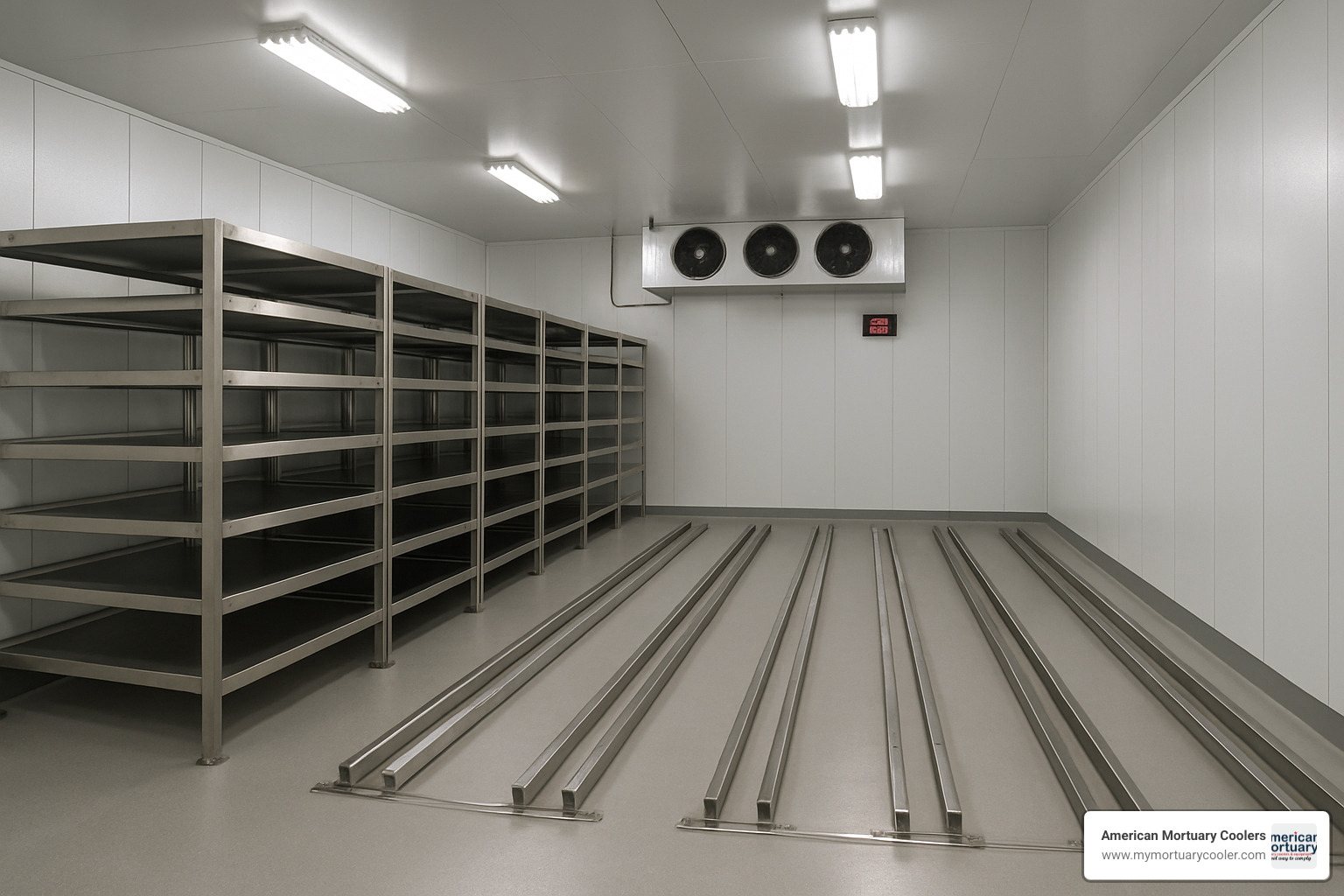
Instead of the freestanding racks you'd find in smaller units, many of these mega-facilities use floor-mounted rail systems that make the most of every square inch while handling heavier loads. The walls themselves are beefed up too, with high-density expanded polystyrene (EPS) panels typically measuring 5½ inches thick – because when you're cooling a space this large, every bit of insulation matters.
"For a 500-body facility, we'll typically design a system with 3-4 independent refrigeration circuits so that a single compressor failure doesn't compromise the entire cooler," explains one of our engineers who specializes in these massive projects. These remote condenser banks not only provide crucial backup but also reject heat more efficiently than single-unit systems.
The most advanced facilities we build at American Mortuary Coolers even incorporate energy recovery systems that capture waste heat from refrigeration equipment and repurpose it for other uses around the facility – like preheating water. It's a smart approach that turns what would be wasted energy into a valuable resource.
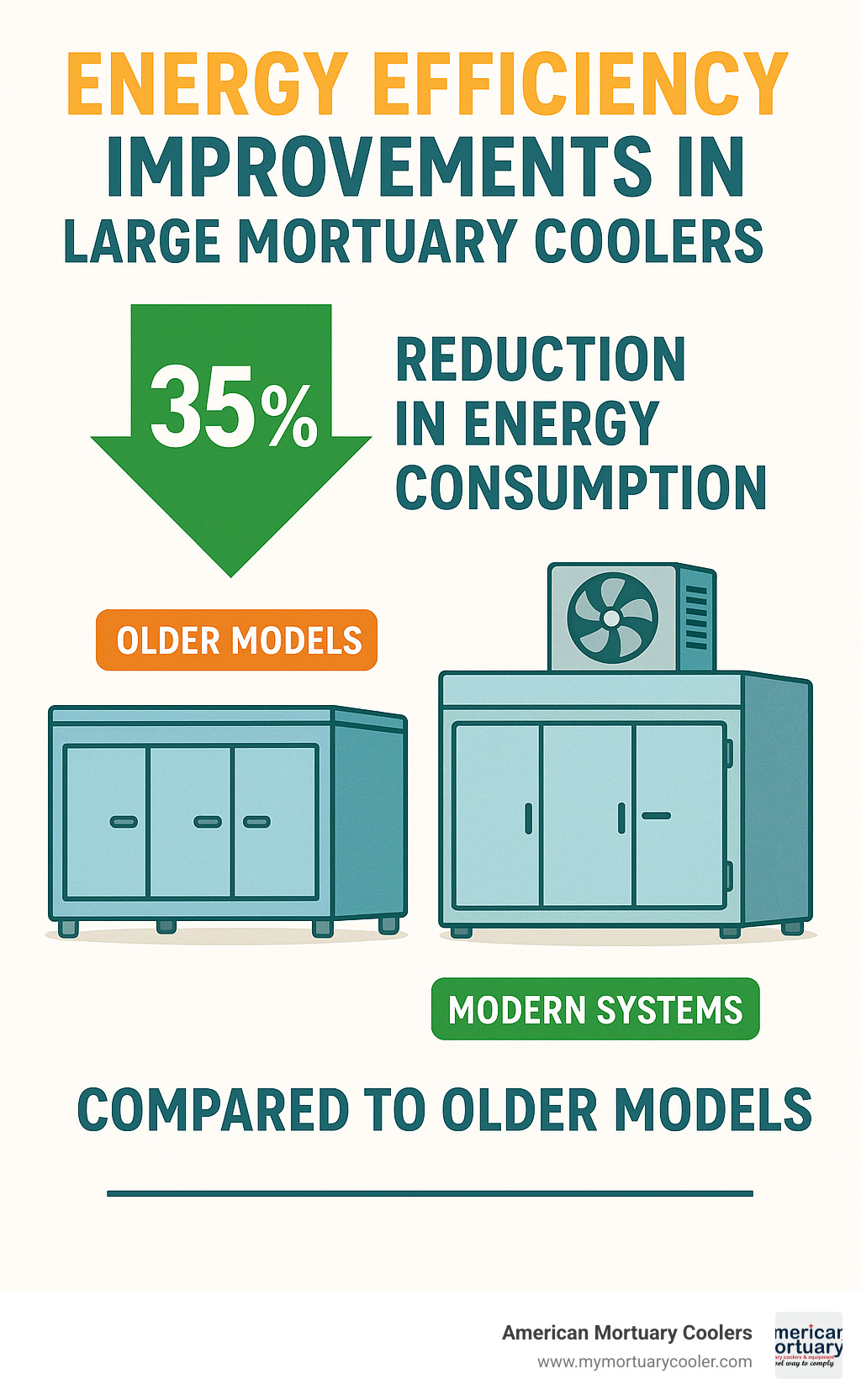
Scientific research on cold storage energy
Construction & Installation Considerations
Installing a 500-body cooler isn't a weekend project – it's a major undertaking that demands careful planning and specialized knowledge.
First things first: you'll need a reinforced concrete slab that can handle serious weight. And not just any slab – it needs to be perfectly level to ensure doors operate smoothly and racks align properly. One eighth of an inch off, and you could be dealing with doors that don't seal correctly.
Most of these large systems require 3-phase power with substantial amperage capacity. And let's be honest – when you're storing 500 bodies, a power failure isn't just an inconvenience, it's a potential disaster. That's why we always recommend backup generators with automatic transfer switches for these installations.
When it comes to moving bodies in and out efficiently, wide doorways and reinforced floors capable of supporting forklifts or pallet jacks are non-negotiable. And unlike smaller units with their hinged doors, many 500-body facilities incorporate sectional or sliding doors that maximize space and make access easier.
"The key to a successful mega-capacity installation is meticulous planning," notes our Southeast Region project manager. "We work closely with the client's architects and engineers from the earliest design phases to ensure all site requirements are properly addressed." It's this attention to detail that has made our large-scale installations so successful over the years.
Energy Efficiency & Operating Costs
Let's talk dollars and cents – because running a refrigerator this size isn't cheap unless you plan for efficiency from the start.
Our 4-inch no-wood panels provide superior thermal performance compared to traditional wood-core panels. Yes, they cost a bit more upfront, but the energy savings add up fast. Think of it as investing in your utility bill's future.
Modern refrigeration systems with variable-speed compressors are game-changers for facilities this size. They adjust cooling capacity based on actual demand rather than running full-blast all the time, which can slash energy consumption during periods when temperatures are stable.
Something as simple as switching to energy-efficient LED lighting with motion sensors can make a surprising difference too. These lights not only use less electricity but also generate less heat – meaning your cooling system doesn't have to work as hard.
Here's a tip that could save you thousands: check with your local utility company about rebate programs for energy-efficient commercial refrigeration. We've seen clients offset 10-15% of their initial costs through these programs.
"We've seen facilities reduce their energy costs by up to 40% by upgrading from older systems to modern, high-efficiency 100 Body Mortuary Cooler designs," reports an energy consultant who works with medical facilities. "The payback period is typically 3-5 years for the premium efficiency components."
It's not just about saving money, though – these efficiency measures also reduce environmental impact and ensure more reliable operation when it matters most.
Top 5 Large-Capacity Mortuary Cooler Solutions in 2024
Shopping for a large-capacity mortuary refrigeration system can feel overwhelming. After all, this is a significant investment that your facility will rely on for years to come. Let's explore the top five solutions available today, from premium custom-built systems to more budget-friendly approaches that won't break the bank.
American Mortuary Coolers Custom 100-Body Unit

Here at American Mortuary Coolers, we take a different approach to large-capacity refrigeration. As a Tennessee-based specialist, we believe every facility deserves a solution custom to their unique needs rather than a one-size-fits-all unit.
"What sets our 100 Body Mortuary Cooler apart is the personal attention we provide throughout the design process," explains our lead engineer. "We actually listen to each client to understand their workflow, space constraints, and future expansion plans."
Our custom units feature 100% Made in USA construction with 4" no-wood insulated panels that exceed DOE standards. We deliver directly to all 48 contiguous states, eliminating middleman markups while offering on-site assembly for those who need it. Our confidence in our craftsmanship shows in our industry-leading 15-year warranty on panels and doors.
Every panel meets EISA 2007 Title III compliance standards, and we include thoughtful touches like UL-approved vapor-proof LED lighting with exterior switches, magnetic door seal gaskets, and self-closing doors that maintain a perfect seal. Pricing varies based on your specific requirements, but clients consistently tell us they appreciate the exceptional value our direct sales model provides.
Arctic Industries MegaStore 96/120 Body Cooler
Not sure if you need 100 bodies of capacity now or might need more later? The Arctic Industries MegaStore series offers a clever solution with its expandable design. Start with 96-body capacity today and grow to 120 bodies as your needs change.
What makes this system popular with teaching hospitals and medical examiner offices is its expandable modular design that adapts to growing caseloads without requiring a complete replacement. The system features EISA-compliant high-R-value panels and remote condensing units that keep operational noise to a minimum. The stainless steel interior makes cleaning and sanitation straightforward, and their nationwide distribution network ensures parts and service are readily available.
AWIC Expandable Series 100 Body Cooler
American Walk-In Coolers (AWIC) has created their Expandable Series with mortuary applications specifically in mind. Their floorless option with NSF cove base has become particularly popular for installations in existing buildings where floor demolition would be problematic.
The attention to detail on these units is impressive, from the LED lighting with pilot-light indicators to magnetic gaskets that create a superior door seal. Their 4" Performance Panel System contains no wood components, eliminating a common failure point in lesser coolers. AWIC also offers customizable rack configurations to match your specific workflow needs. All components comply with federal energy standards and carry UL-NSF approval.
Mobi Medical Rapid Response 100
Sometimes you need capacity yesterday. The Mobi Medical Rapid Response 100 was designed for exactly these scenarios, offering quick-deploy design that can be operational within days of delivery.
This innovative system features self-contained plug-in refrigeration that works with standard 220V power, making it ideal for disaster response or temporary capacity during renovations. The optional castor base adds mobility, while the digital thermometer and adjustable controller ensure precise temperature management.
"When Hurricane Katrina hit, we deployed three Mobi units in less than 72 hours," shared one emergency management director. "The modular components made transport and setup possible even in challenging conditions."
While it's not as energy-efficient as permanent installations, its flexibility makes it an excellent option for certain scenarios where speed is essential.
CoolBot Pro DIY 100-Body Walk-In
For the budget-conscious facility with existing structures, the CoolBot Pro offers an inventive approach to large-capacity refrigeration. By combining standard air conditioners with the CoolBot controller, you can create functional mortuary coolers at a fraction of traditional system costs.
The significantly lower initial investment makes this approach particularly attractive for smaller operations or as backup systems. The WiFi temperature alerts and monitoring provide peace of mind, while the mobile app lets you check conditions remotely. The system stores 30 days of temperature history for compliance documentation.
One Southern California funeral director shared: "With the 8'x12' CoolBot and a 12,000 BTU AC unit, I've built the largest refrigeration facility for human remains in my region for about $5,000."
While this DIY approach may not match the long-term durability of purpose-built systems, its affordability makes it worth considering, especially when budget constraints would otherwise prevent expanding capacity.
Each of these solutions offers unique advantages depending on your facility's specific needs, timeline, and budget. We're happy to discuss which might be the best fit for your situation – just reach out and let us know what challenges you're facing.
Installation, Maintenance & Compliance Essentials
Proper installation and ongoing maintenance are crucial for the safe, efficient operation of any 100 Body Mortuary Cooler. Here are the essential considerations for keeping your large-capacity system running smoothly.
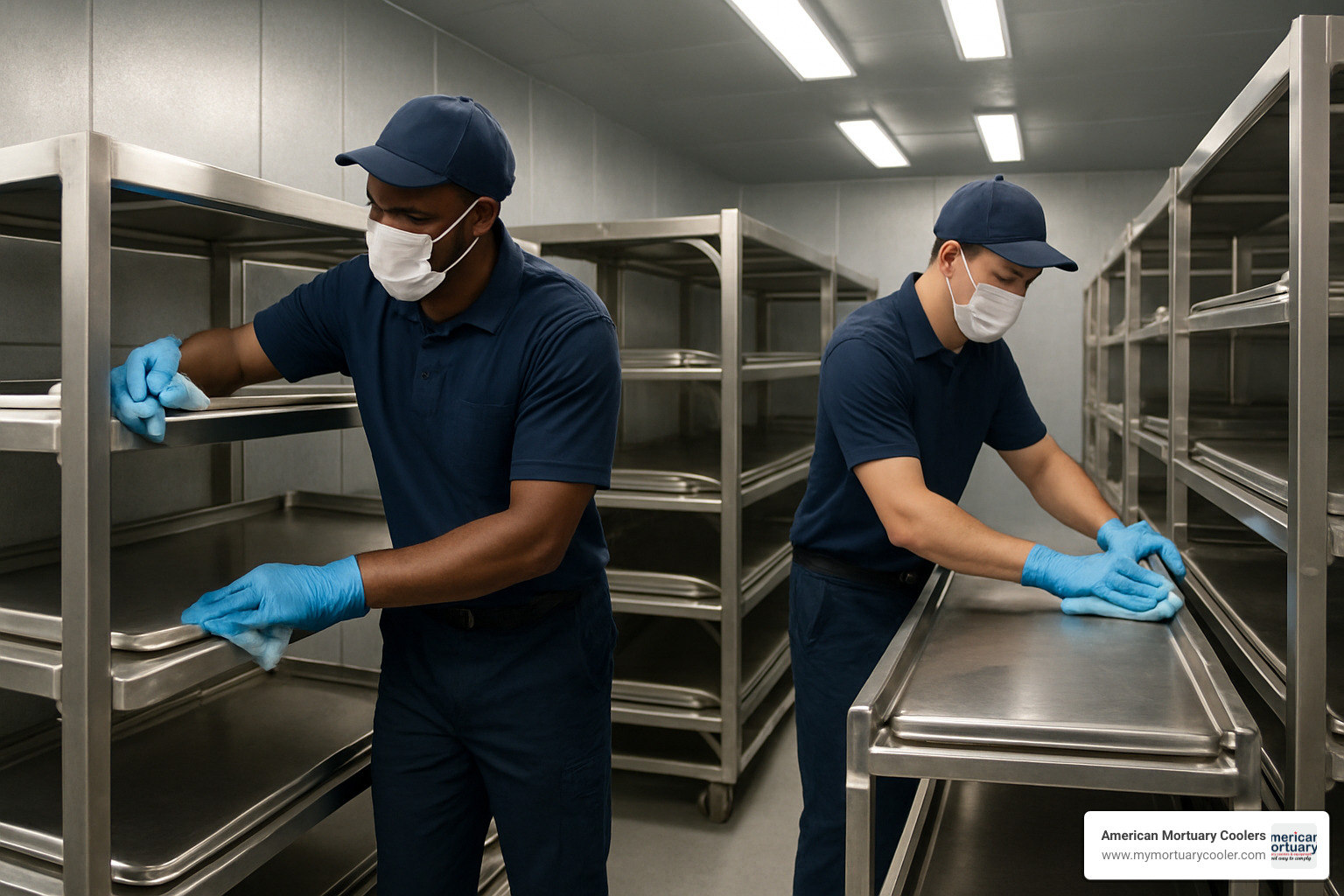
When we install large-capacity systems at American Mortuary Coolers, we always emphasize the importance of proper floor drainage. You'll want floors that slope gently toward drains, making cleanup easier while ensuring all penetrations are properly sealed to maintain the vapor barrier. Trust me, good drainage makes a world of difference during those quarterly deep cleans!
Sanitation considerations shouldn't be an afterthought. We've found that non-porous surfaces like stainless steel aren't just pretty - they're practical workhorses that stand up to frequent cleaning. That's why we recommend stainless for both racks and interior wall panels in all our 100 Body Mortuary Cooler installations.
"I learned the hard way that skipping maintenance leads to expensive emergency repairs," one of our long-time customers recently told me. We recommend a simple but consistent schedule: weekly temperature log verification, monthly condenser cleaning, and quarterly full-system inspections. These basic steps can add years to your system's life.
Don't forget about OSHA compliance - your staff's safety matters! When we design multi-tier rack systems, we always discuss mechanical lift options with clients. Your team's backs will thank you, and you'll avoid potential workplace injuries and complaints.
As for EPA refrigerant regulations, they're constantly evolving. Modern systems should use environmentally friendly refrigerants that comply with current EPA guidelines. Many older refrigerants are being phased out, so if you're upgrading from an aging system, this is a perfect opportunity to go green.
"Preventative maintenance is absolutely critical for large-capacity mortuary coolers," our service manager often reminds clients. "A minor issue that might go unnoticed in a small unit can quickly become catastrophic in a 100-body system. It's like ignoring a small leak in a boat - eventually, you'll sink!"
For more information, check out our complete guide to mortuary coolers and requirements.
Cleaning & Disinfection Protocols
I'll never forget walking into a poorly maintained mortuary cooler during a consultation visit - the smell told me everything I needed to know about their cleaning protocols (or lack thereof). Don't let this happen to you!
When choosing cleaning solutions, stick with stainless-steel-safe disinfectants that won't damage interior surfaces or create harmful fumes in that enclosed space. The last thing you want is corroded racks or lingering chemical odors.
One feature our clients particularly appreciate in our 100 Body Mortuary Cooler designs is removable trays that can be thoroughly cleaned outside the cooler. This seemingly small detail makes a huge difference in maintaining proper sanitation.
We typically recommend a quarterly deep cleaning schedule that includes removing all racks, sanitizing all surfaces, and carefully inspecting for any signs of mold or corrosion. Think of it as a seasonal refresh for your system.
"We recommend a rotating cleaning schedule that allows sections of the cooler to be thoroughly cleaned without completely emptying the unit," our operations specialist often suggests. "This approach maintains sanitation standards while minimizing disruption to your daily operations."
Meeting Safety & Regulatory Standards
Navigating regulations can feel overwhelming, but we're here to help. Large-capacity mortuary refrigeration systems must comply with several important standards:
CDC guidelines provide specific recommendations for handling human remains, including refrigeration requirements. These guidelines aren't just bureaucratic red tape - they're designed to protect public health and ensure dignity for the deceased.
State health codes vary considerably, which is why our team stays current on requirements across all 48 contiguous states we serve. Most states establish minimum standards for mortuary refrigeration temperature (typically 36-39°F), capacity requirements, and record-keeping protocols.
UL listing for electrical components isn't optional - it's essential for safety and insurance purposes. Your overall system should meet relevant electrical codes, which our installation team can help you steer.
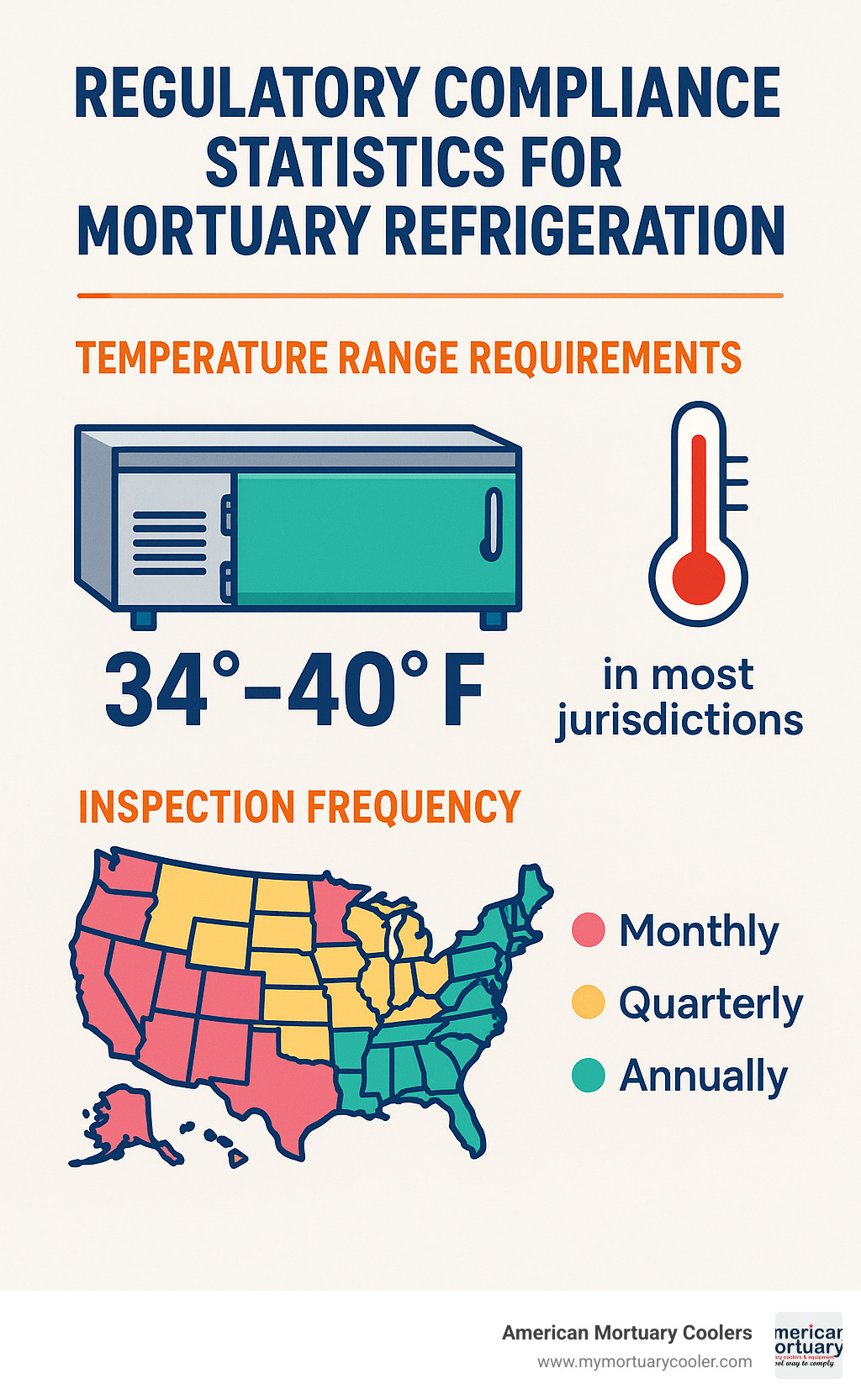
At American Mortuary Coolers, we ensure all our systems meet or exceed these standards. As our compliance officer likes to say, "Regulatory compliance isn't just about avoiding fines—it's about ensuring the safety of staff and the dignity of the deceased." That's a principle we take to heart in every system we build.
Frequently Asked Questions about 100 Body Mortuary Coolers
What power and space do I need for a 100-body unit?
I've heard this question from nearly every facility manager I've worked with. Setting up a 100 Body Mortuary Cooler isn't like installing a household refrigerator - it requires careful planning around your infrastructure.
For electrical needs, you'll typically need 220/230V AC service, often 3-phase, with 50-60 amp capacity. Don't overlook backup power - a generator isn't just a nice-to-have, it's absolutely essential for maintaining dignity and preservation during outages.
Space-wise, you're looking at roughly 600-900 square feet for the cooler itself. But here's where many folks get caught short: you need additional space for comfortable access aisles and equipment. I remember visiting one hospital that technically had enough square footage, but staff could barely maneuver between racks!
"I always tell clients to imagine staff moving gurneys during a busy period," says Tom, our installation team lead. "That extra three feet of clearance might seem unnecessary on paper, but it makes all the difference in daily operations."
Your ceiling should be at least 8 feet high, though 10-12 feet gives you ideal air circulation. And don't forget about your foundation - you'll need reinforced concrete capable of supporting 150-200 pounds per square foot to handle fully-loaded racks safely.
How do I finance a large-capacity mortuary cooler?
Let's talk money - because a 100 Body Mortuary Cooler represents a significant investment in your facility's infrastructure. The good news? You've got options.
Many of our clients have found success with equipment leasing programs that offer 3-7 year terms. These often come with attractive tax advantages that can make a big difference to your bottom line. For smaller funeral homes or medical facilities, SBA loans frequently provide favorable terms designed specifically for essential equipment purchases.
Government facilities have their own pathway through municipal bonds, which typically offer excellent long-term financing rates. And at American Mortuary Coolers, we understand the financial challenges our clients face, which is why we offer direct financing options with terms competitive with traditional lenders.
One financing avenue that's often overlooked? Grant funding. "Last year, we helped three county morgues secure disaster preparedness grants that covered about 30% of their installation costs," shares Sarah from our financing team. "Many communities have emergency management funds that can be applied toward essential infrastructure like mortuary cooling."
Don't let sticker shock prevent you from getting the equipment you need - talk to us about creating a financing solution that works for your specific situation.
Can I upgrade from 100 to 500 bodies later?
Yes! With thoughtful initial planning, your 100 Body Mortuary Cooler can absolutely grow with your needs. I've helped numerous facilities design systems with future expansion in mind.
The secret lies in modular construction. Our panel systems are designed so walls can be removed and your cooler footprint expanded without starting from scratch. Many forward-thinking clients opt for slightly oversized refrigeration systems during initial installation - this might mean a small premium upfront, but it provides immediate capacity for future expansion without replacing your entire cooling system.
Rack systems can also be designed with growth in mind. We can create configurations that allow for additional tiers or rows to be added as your needs evolve.
"The most successful expansions happen when clients share their five-year vision during our first conversation," explains our project manager Mike. "Even if budget constraints mean starting smaller, knowing where you want to end up helps us design a system that can grow efficiently."
One county medical examiner I worked with started with a 75-body system but knew they might need to expand. By planning ahead, when they needed to increase capacity three years later, we were able to expand to 150 bodies without replacing any of their original investment - just adding compatible components to what they already had.
A little foresight today can save substantial money tomorrow when your needs inevitably change.
Conclusion
Investing in a 100 Body Mortuary Cooler is much more than a purchase—it's a commitment to serving your community with dignity and preparedness. These systems provide essential infrastructure that can make all the difference during both everyday operations and those challenging moments that test our resilience.
The past few years have taught us all a sobering lesson about the importance of adequate mortuary capacity. When facilities invest proactively in appropriate refrigeration systems, they position themselves to respond with compassion and professionalism even in the most difficult circumstances. This preparedness isn't just good business—it's about honoring our shared responsibility to care for the deceased with respect.
"The peace of mind that comes with knowing we can handle whatever comes our way is invaluable," shared one hospital administrator after installing their 100-body system. "It's an investment in our community's wellbeing that we hope to rarely use at full capacity, but are grateful to have when needed."
At American Mortuary Coolers, we take tremendous pride in supporting facilities across the country with thoughtful, durable solutions. From our Tennessee headquarters, our team reaches clients in every corner of the nation—from the busy Northeast to the sun-drenched Southwest, the heartland Midwest to the coastal Pacific regions. We're not just selling coolers; we're building partnerships with the professionals who perform some of society's most essential work.
Whether you're in the planning stages for a brand-new facility, looking to upgrade aging infrastructure, or developing robust emergency response capabilities, we'd love to have a conversation about your specific needs. Our direct delivery model eliminates middlemen, while our custom manufacturing approach ensures you get exactly the system your operation requires—balancing capacity needs, budget realities, and day-to-day operational demands.
The right mortuary refrigeration solution provides more than just temperature control—it delivers confidence, efficiency, and the ability to serve with excellence, no matter what challenges tomorrow may bring. We'd be honored to help you build that foundation of readiness and respect.
For more information about choosing the right walk-in mortuary cooler for your facility, explore our comprehensive resources on our website.



















